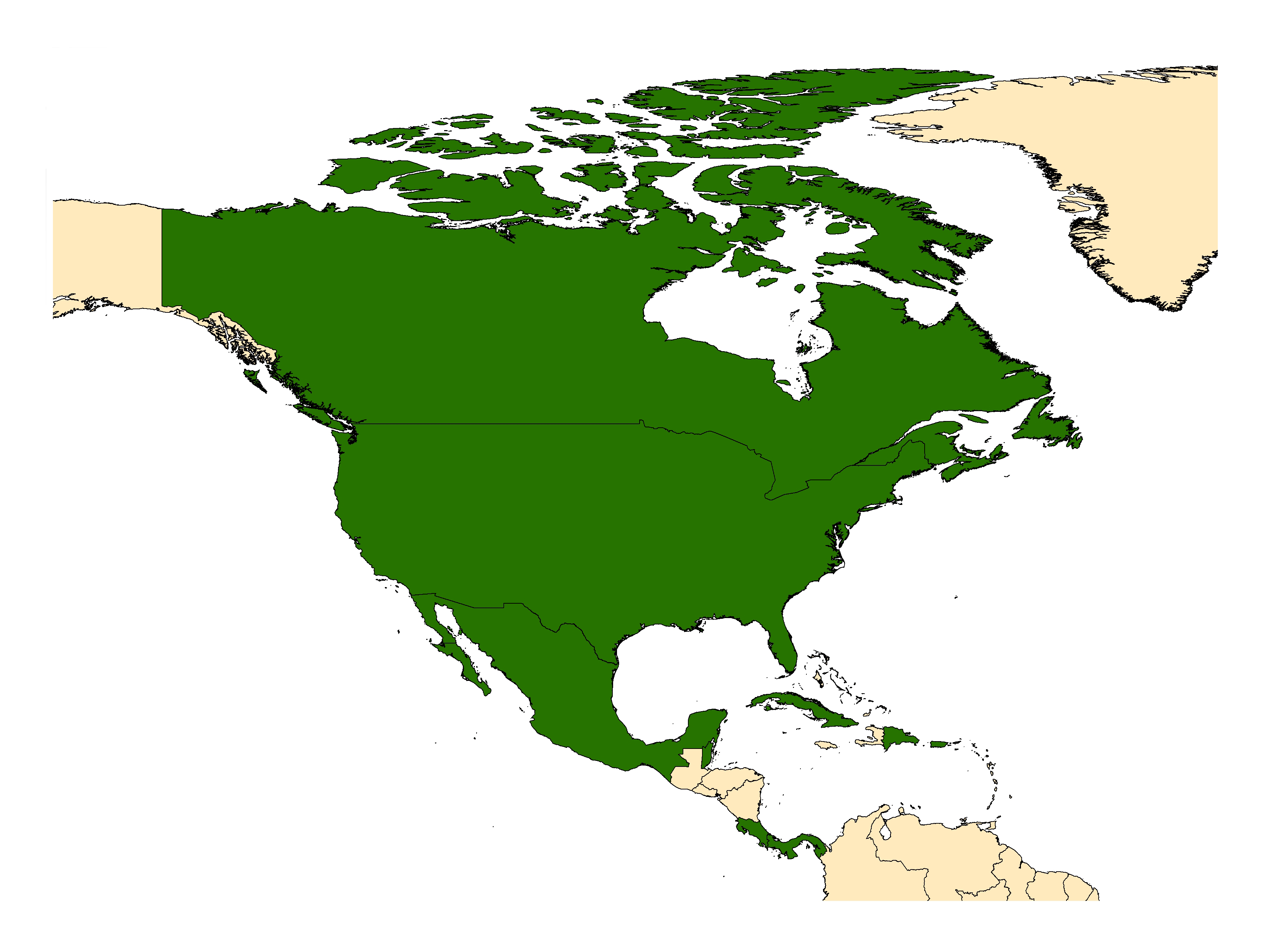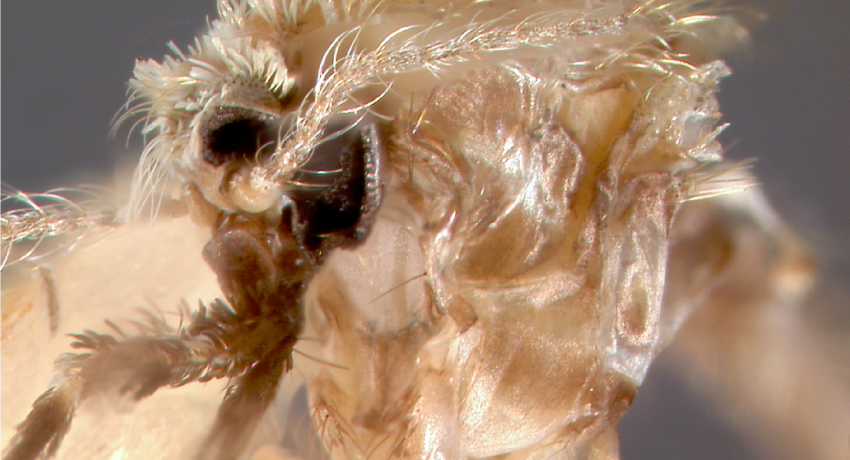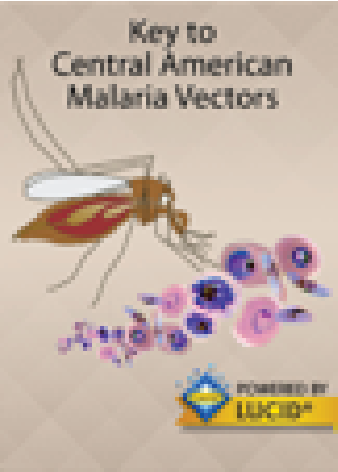NEARCTIC REGION
Etymology: four spots (L); on wing
Anopheles quadrimaculatus is a large mosquito, named after the distinctive four dark spots on its wings. IT is the nominotypical member of the Quadrimaculatus Subgroup, where it is placed along with four essentially isomorphic Nearctic sister taxa—An. diluvialis Reinert, An. inundatus Reinert, An. maverlius Reinert and An. smaragdinus Reinert—and the Palearctic species An. beklemshevi Stegnii & Kabanova, which appears basal to all Nearctic taxa in phylogenetic treatments. The other Nearctic taxa are sympatric with An. quadrimaculatus and were differentiated following a series of genetic crossing, isozyme, and cytological studies. DNA methods are routinely used to differentiate them. Anopheles quadrimaculatus has one valid synonym—An. annulimanus van der Wulp.
Type locality: Wabasha, Minnesota, United States
Type depository: Type non-existent (NE)
DIAGNOSTIC CHARACTERS (Click photos to view; mouse over and click large photo to zoom in.)
ADULT (illustrated): Head: Palpus all dark-scaled; vertex and frontal tuft with pale scales and setae. Thorax: Length of dorsal dark scutal setae <0.5 x width of scutum. C-I without black scales. Capitellum of halter dark-scaled. Wing: Wing without contrasting pale markings and with 4 distinct concentrations of dark scales; apex of wing all brown-scaled; vein 1A dark-scaled.
LARVA (not illustrated): Head: Seta 2-C usually single or finely aciculate, separated by width of one alveolus or more. Seta 3-C with 15–40+ branches. Seta 1-A branched, inserted on basal 0.25-0.50 of antenna; seta 4-C inserted posterior to 2,3-C. Abdominal segments: Seta 1-II palmate, usually well-developed; seta 6-VI minute, branched.
TAXONOMIC KEYS
Roth 1944
Pelaez 1945
Carpenter & LaCasse 1955
Wilkerson & Strickman 1990
Dodge 1966
Reinert et al. 1997
Darsie & Ward 2005
Beltrán-Aguilar et al. 2011
Harrison et al. 2016
![]()
Anopheles – Central America - Adult
![]()
Anopheles – Central America - Larva
![]()
WRBU - Genera - Global - Adult
![]()
WRBU - Genera - Global - Larva
![]()
WRBU - Genera - Nearctic - Adult
![]()
WRBU - Genera - Nearctic - Larva
![]()
WRBU - Genera - Neotropical - Adult
![]()
WRBU - Genera - Neotropical - Larva
Exemplar DNA sequences
An. quadrimaculatus COI: GU908030-41; KT707126; KR663155
BIONOMICS
Immatures
Typical An. quadrimaculatus immature habitats are open sunlit fresh water ground pools that are slightly alkaline with abundant floating and emergent vegetation, where the larvae feed on algae, rod-shaped bacteria, and protozoa. These sites usually include ponds, swamps, bayous, borrow pits, however, immatures have been occasionally recovered from tin cans, barrels, cornfield furrows, and even in heavily polluted waters.
Adults
Anopheles quadrimaculatus often occurs in huge numbers—tarp collections of 7,000 per night are common in the Mississippi Delta and Gulf of Mexico. These extraordinary densities, coupled with a ferocious appetite for human blood, secured the species major malaria vector status, along with its role in malaria endemics in the pre-1950s in the southeastern United States. Fertilized females overwinter in basements, sheds and tree hollows.
DISTRIBUTION NOTES
Belize, Canada, Costa Rica, Cuba, Dominican Republic, Mexico, Panama, Puerto Rico, United States (continental).

WRBU VECTOR HAZARD REPORTS
VHR: Mosquitoes of the Caribbean
View other WRBU Vector Hazard Reports
Available GIS Models:
An_quadrimaculatus_Benedict_1 North America
An_quadrimaculatus_Dornak_1 North America
IMPORTANT REFERENCES (full citations below)
Say, 1824: 356 (F)
Howard et al. 1913 (1912): Fig. 695 (E*)
Roth 1944: 101 (M*), 107 (M keys)
Aitken 1945: 280 (taxonomy)
Pelaez 1945: 74 (F*; key)
Ross 1947 (F*)
Penn 1949a: 56 (P*)
Yamaguti & LaCasse 1950b: 27 (M*, F*, L*; sensu lato)
Breeland 1951: 224 (L*)
Carpenter & LaCasse 1955: 50 (M*, F*, L*; keys)
Belkin et al. 1966: 3 (restriction of type locality)
Dodge 1966: 364 (1st instar L*; key; sensu lato)
Wilkerson & Strickman 1990 (keys; Central America)
Linley et al. 1993a (E*)
Porter & Collins 1996 (molecular phylogenetics Nearctic)
Reinert et al. 1997: 22 (M*, F*, P*, L*, E*; keys, bionomics, medical importance; neotype designation)
Reinert 1997b (bibliography)
Levíne et al. 2004 (molecular identification, distribution, niche model)
Darsie & Ward 2005 (F*, L*; keys, distribution)
Sinka et al. 2010: 72 (Quadrimaculatus Subgroup; bionomics review, distribution, niche model)
Beltrán-Aguilar et al. 2011: 695 (M*, F*, P*, L*; taxonomy, keys, distribution)
Harrison et al. 2016 (F*, L*; keys, distribution, taxonomy; sensu stricto & sensu lato, notes 9, 18)
CURRENT SYNONYMS
syn. annulimanus van der Wulp
1867: 129 (M*). Type locality: Wisconsin, United States (LM). References: Belkin et al. 1966: 3 (restriction of type locality); Belkin 1968b: 9 (taxonomy).
CITED REFERENCES
Aitken, T.H.G. (1945). Studies on the anopheline complex of western America. University of California Publications in Entomology, 7(11), 273–354.
Belkin, J.N. (1968b). Mosquito studies (Diptera, Culicidae). IX. The type specimens of New World mosquitoes in European museums. Contributions of the American Entomological Institute, 3(4), 1–69.
Belkin, J.N., Schick, R.X., & Heinemann, S.J. (1966). Mosquito studies (Diptera: Culicidae). VI. Mosquitoes originally described from North America. Contributions of the American Entomological Institute, 1(6), 1–39.
Beltrán-Aguilar, A., Ibañez-Bernal, S., Mendoza-Palmero, F., Sandoval-Ruiz, C.A., & Hernández-Xoliot, R.A. (2011). Taxonomy and distribution of the anopheline mosquitoes in the state of Veracruz, Mexico (Diptera: Culicidae, Anophelinae). Acta Zoologica Mexicana Nueva Serie, 27(3), 601–755.
Breeland, S.G. (1951). The identification of the early larval instars of three common anophelines of southern Georgia, U.S.A. Journal of the U.S.A. National Malaria Society, 10, 224–232.
Carpenter, S.J., & LaCasse, W.J. (1955). Mosquitoes of North America (North of Mexico). Berkeley, Los Angeles: University of California Press.
Darsie, R.F., Jr., & Ward, R.A. (2005). Identification and geographical distribution of the mosquitoes of North America, north of Mexico. Gainesville, FL: University Press of Florida.
Dodge, H. R. (1966). Studies on mosquito larvae II. The first-stage larvae of North American Culicidae and of world Anophelinae. Canadian Entomologist, 98, 337–393.
Harrison, B.A., Byrd, B.D., Sither, C.B., & Whitt, P.B. (2016). The mosquitoes of the Mid-Atlantic Region: an identification guide (Vol. 1). Madison Heights, MI: Publishing XPress.
Hay, S.I., Sinka, M.E., Okara, R.M., Kabaria, C.W., Mbithi, P.M., Tago, C.C., …Godfray, H.C.J. (2010). Developing global maps of the dominant Anopheles vectors of human malaria. PLoS Medicine, 7(2): e1000209.
Howard, L.O., Dyar, H.G., & Knab, F. (1913). The mosquitoes of North and Central America and the West Indies. (Vol. II) (1912). Washington, D.C.: Carnegie Institution of Washington.
Levine, R.S., Peterson, A.T., & Benedict, M.Q. (2004). Distribution of members of Anopheles quadrimaculatus Say s.l. (Diptera: Culicidae) and implications for their roles in malaria transmission in the United States. Journal of Medical Entomology, 41(4), 607–613.
Linley, J.R., Kaiser, P.E., & Cockburn, A.F. (1993a). A description and morphometric study of the eggs of species of the Anopheles quadrimaculatus complex (Diptera: Culicidae). Mosquito Systematics, 25(2), 124–147.
Pelaez, D. (1945). Anofelinos de México. Clave para la determinación de especies y subespecies basada en los caracteres de las hembras adultas. Ciencia, 6, 69–77.
Penn, G.H. (1949a). Pupae of the Nearctic anopheline mosquitoes north of Mexico. Journal of the National Malaria Society, 8, 50–69.
Porter, C.H., & Collins, F.H. (1996). Phylogeny of Nearctic members of the Anopheles maculipennis species group derived from the D2 variable region of 28S ribosomal RNA. Molecular Phylogenetics and Evolution, 6, 178–188.
Reinert, J.F. (1997b). Bibliography of Anopheles quadrimaculatus Say sensu lato. Journal of the American Mosquito Control Association, 13 (Supplement), 112–161.
Reinert, J.F., Kaiser, P.E., Seawright, J.A. (1997). Analysis of the Anopheles (Anopheles) quadrimaculatus complex of sibling species (Diptera: Culicidae) using morphological, cytological, molecular, genetic, biochemical, and ecological techniques in an integrated approach. Journal of the American Mosquito Control Association, 13(Suppl.), 1–102.
Ross, H.H. (1947). The mosquitoes of Illinois (Diptera, Culicidae). Bulletin of the Illinois Natural History Survey, 24(1), 1–96.
Roth, L.M. (1944). A key to the Anopheles of the southeastern United States, by male genitalia (Diptera, Culicidae). The American Midland Naturalist, 31, 96–110.
van der Wulp, F.M. (1867). Eenige Noord-Americaansch Diptera. Tijdschrift voor Entomologie, 10, 125–164.
Wilkerson, R.C., & Strickman, D. (1990). Illustrated key to the female anopheline mosquitoes of Central America and Mexico. Journal of the American Mosquito Control Association, 6, 7–34.
Yamaguti, S., & LaCasse, W.J. (1950b). Mosquito fauna of North America. Part I. Genus Anopheles. Office of the Surgeon, HQ. 8th Army.
CITE THIS PAGE
Walter Reed Biosystematics Unit (Year). Anopheles quadrimaculatus species page. Walter Reed Biosystematics Unit Website, http://wrbu.si.edu/vectorspecies/mosquitoes/quadrimaculatus, accessed on [date (e.g. 03 February 2020) when you last viewed the site].












































































































































































